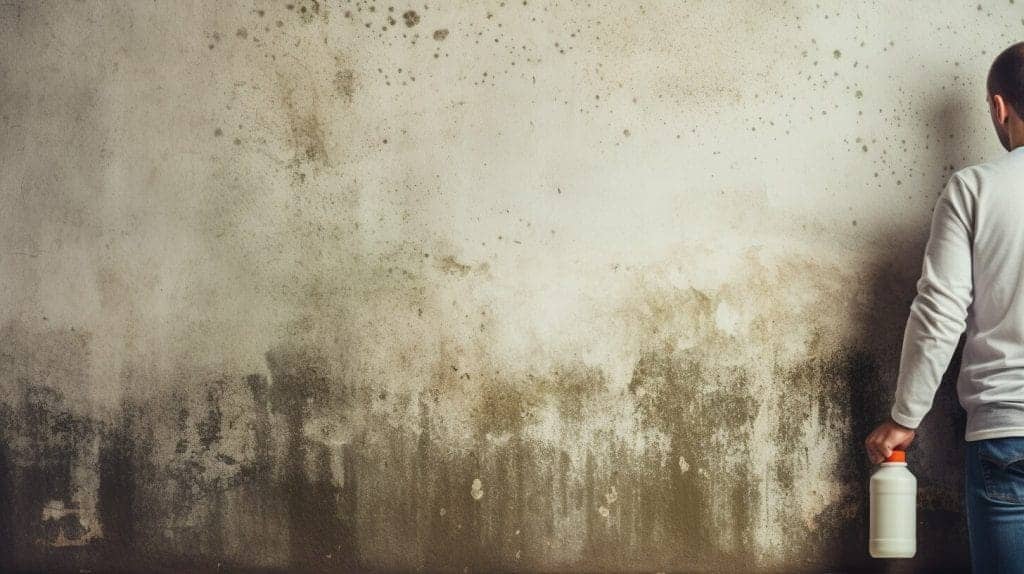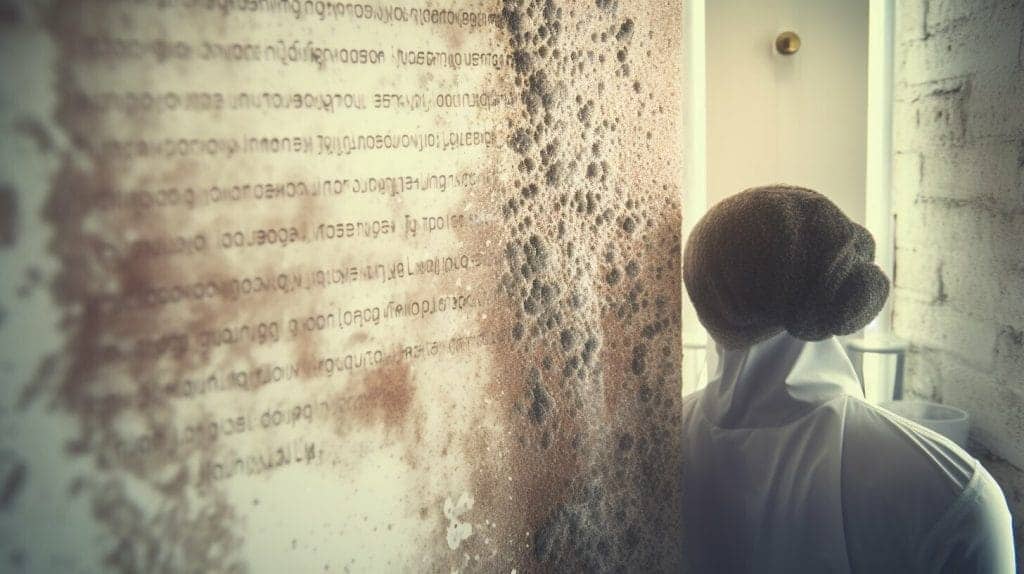Aspergillus mold is a common type of fungus that can be found both indoors and outdoors. While not all species of Aspergillus mold are toxic, some have the potential to produce harmful toxins that can cause serious health problems.
This article aims to provide you with essential information about Aspergillus mold toxicity, including its potential health risks, the different species that produce toxins, and strategies to protect yourself from exposure. Read on to learn more about this dangerous fungus and how to stay safe from harm.
What is Aspergillus Mold?
Aspergillus is a common type of mold that can be found both indoors and outdoors. It can grow on a variety of surfaces, including food, soil, decaying plants, and building materials like walls and insulation. Aspergillus is a type of fungi that has many different species, some of which have the potential to be toxic to humans.
Aspergillus mold is comprised of small, airborne spores that spread easily through the air. When inhaled, Aspergillus spores can cause a range of health problems, from minor allergies to serious respiratory infections, especially for those with weakened immune systems. Additionally, some species of Aspergillus can produce toxins called mycotoxins, which can cause liver damage, cancer and other serious health issues.
Are All Species of Aspergillus Mold Toxic?
Aspergillus mold is a type of fungus that can grow in various environments, including indoor and outdoor spaces. While some species of Aspergillus mold are harmless, others can be hazardous to human health.
The answer to the question of whether all species of Aspergillus mold are toxic is no. While most species of Aspergillus mold are not toxic to humans, there are a few that are known to produce mycotoxins, which can cause a range of health problems, from respiratory issues to allergic reactions.
It’s essential to note that even non-toxic species of Aspergillus mold can still cause health problems in certain individuals, especially those with weakened immune systems or respiratory conditions.
| Toxic Species of Aspergillus Mold | Non-Toxic Species of Aspergillus Mold |
|---|---|
| Aspergillus flavus | Aspergillus niger |
| Aspergillus fumigatus | Aspergillus oryzae |
| Aspergillus parasiticus | Aspergillus terreus |
It’s important to identify which species of Aspergillus mold is present in your environment to determine whether it poses a threat to your health. If you suspect that you have Aspergillus mold in your home or workplace, it’s crucial to seek professional help to remove it safely.
Harmful Effects of Aspergillus Mold
Exposure to Aspergillus mold can pose a significant threat to human health. Aspergillus mold can cause respiratory issues and infections, especially in individuals with weakened immune systems.
Aspergillosis is the term used to describe the different types of infections caused by Aspergillus mold. These infections can range from mild to severe, with some types of aspergillosis being life-threatening.
| Type of Aspergillosis | Symptoms |
|---|---|
| Allergic bronchopulmonary aspergillosis (ABPA) | Shortness of breath, wheezing, coughing, fever |
| Aspergilloma | Chest pain, coughing up blood, difficulty breathing |
| Invasive aspergillosis | Fever, chills, cough, chest pain, shortness of breath, headache, confusion |
It’s essential to seek medical attention if you experience any symptoms related to Aspergillus mold exposure.
Individuals with underlying respiratory conditions, such as asthma or cystic fibrosis, or those undergoing treatments that weaken their immune systems, such as chemotherapy or organ transplants, are at a higher risk of developing severe aspergillosis infections from exposure to Aspergillus mold.
Prevention
The best way to prevent Aspergillus mold exposure is to control the moisture levels in your home or workplace. This includes fixing any leaky pipes or roofs, using proper ventilation in high humidity areas, and avoiding indoor plants that can promote mold growth.
It’s also essential to wear personal protective equipment, such as masks and gloves, if you are working in areas where Aspergillus mold is present.
If you suspect mold growth in your home or workplace, it’s crucial to have it inspected and removed by a professional as soon as possible to reduce the risk of exposure.
Potential Toxin-Producing Aspergillus Species
While not all species of Aspergillus mold are toxic, there are several that have been identified as potential toxin-producers. These strains are particularly concerning as they can lead to serious health risks when inhaled or ingested, especially in individuals with weakened immune systems.
| Species of Aspergillus Mold | Toxic Properties |
|---|---|
| Aspergillus flavus | Produces aflatoxins, which are known carcinogens and can cause liver damage |
| Aspergillus fumigatus | Produces mycotoxins that can cause respiratory infections and allergic reactions |
| Aspergillus niger | Produces ochratoxins, which can damage the kidneys and liver, and can also cause respiratory infections |
It is important to note that the presence of these species does not necessarily mean that toxins will be produced. However, the potential for toxicity makes it essential to take proper precautions to avoid exposure to Aspergillus mold.
Dangers of Aspergillus Mold
Aspergillus mold can pose a significant threat to human health, especially for those with weakened immune systems. Exposure to this mold can result in respiratory issues and infections such as aspergillosis, which can be life-threatening in some cases.
What makes Aspergillus mold particularly dangerous is that some species have the ability to produce toxins, which can cause a range of harmful effects on the body. These toxins are known as mycotoxins and can cause serious health problems if ingested or inhaled.
In more severe cases, exposure to Aspergillus mold can lead to the development of invasive aspergillosis, which can cause a range of symptoms including fever, coughing, and shortness of breath. This condition is more common in those with weakened immune systems, such as cancer patients, transplant recipients, and those with HIV/AIDS.
It is important to take Aspergillus mold seriously and take steps to prevent exposure in order to protect your health and the health of your loved ones.
How to Protect Yourself from Aspergillus Mold
While Aspergillus mold can be harmful, there are ways to protect yourself and minimize your risk of exposure. Here are some tips:
- Identify potential sources of Aspergillus mold: Common sources of Aspergillus mold include soil, decaying organic matter, and food. Keep an eye out for areas where these sources may be present, such as damp environments or poorly ventilated spaces.
- Maintain good ventilation: Proper ventilation can help reduce the amount of Aspergillus mold in the air. Make sure to keep windows open, use exhaust fans in the kitchen and bathroom, and use an air purifier with a HEPA filter.
- Keep your home dry: Aspergillus mold thrives in damp environments, so it’s important to keep your home dry. Repair any leaks, dry wet areas immediately, and use a dehumidifier if necessary.
- Clean up mold promptly: If you spot mold in your home, clean it up promptly. Use a solution of bleach and water to kill the mold and prevent it from spreading.
- Protect your immune system: If you have a weakened immune system, you may be more susceptible to the harmful effects of Aspergillus mold. Take steps to protect your immune system, such as getting enough sleep, eating a healthy diet, and staying hydrated.
By following these tips, you can help protect yourself and your loved ones from the potential harmful effects of Aspergillus mold.
Toxicological Effects of Aspergillus Species
Aspergillus mold can cause a range of health problems, from minor respiratory irritation to severe infections. However, some species of Aspergillus are more dangerous than others due to their potential to produce toxins.
One of the most toxic species of Aspergillus is Aspergillus flavus. This mold is known for producing a potent carcinogen called aflatoxin, which has been linked to liver cancer in humans and animals. Aflatoxin is a potent toxin that can cause significant damage to the liver, leading to acute liver failure, cirrhosis, and liver cancer.
Another toxic species of Aspergillus is Aspergillus fumigatus. This mold produces a toxin called gliotoxin, which can cause a range of dangerous health effects, including severe respiratory infections, allergies, and immune system suppression. Gliotoxin is known to be particularly dangerous for people with weakened immune systems, such as those living with HIV or undergoing chemotherapy.
What are the symptoms of Aspergillus mold toxicity?
The symptoms of Aspergillus mold toxicity depend on the species of Aspergillus, the length of exposure, and the individual’s sensitivity to the mold. Common symptoms of exposure to Aspergillus mold include:
- Coughing and wheezing
- Shortness of breath and chest tightness
- Fever and chills
- Fatigue and weakness
- Headaches and dizziness
- Allergic reactions, such as rashes and hives
If you believe you have been exposed to Aspergillus mold, it’s important to seek medical attention immediately, especially if you are experiencing any of the above symptoms.
FAQ – Frequently Asked Questions about Aspergillus Mold Toxicity
Q: Is all Aspergillus mold toxic?
No, not all species of Aspergillus mold are toxic. However, some species do have the potential to produce toxins that can be harmful to human health.
Q: What are the symptoms of Aspergillus mold exposure?
The symptoms of Aspergillus mold exposure can vary depending on the individual and the severity of the exposure. Common symptoms include respiratory issues such as coughing and wheezing, as well as fever, headaches, and allergic reactions.
Q: How can I tell if I have Aspergillus mold in my home?
Aspergillus mold can be identified through visual inspection or by performing air or surface tests. If you suspect that you have Aspergillus mold in your home, it is best to contact a professional to perform an inspection and determine the best course of action.
Q: Can Aspergillus mold be removed?
Yes, Aspergillus mold can be removed through a variety of methods including physical removal, the use of fungicides, and proper ventilation and cleaning practices. However, it is important to address the root cause of the mold growth to prevent future infestations.
Q: Are there any risks associated with removing Aspergillus mold?
Yes, there are risks associated with removing Aspergillus mold, including the potential for spores to become airborne and spread throughout the home. It is important to take proper precautions and enlist the help of a professional to ensure safe and effective removal.
Q: How can I protect myself from Aspergillus mold exposure?
To protect yourself from Aspergillus mold exposure, it is important to maintain a clean and dry living environment, use proper ventilation in areas such as bathrooms and kitchens, and address any water damage or moisture issues promptly. It is also recommended to wear a protective mask when performing activities that may disturb mold growth.
Dr. Francisco Contreras, MD is a renowned integrative medical physician with over 20 years of dedicated experience in the field of integrative medicine. As the Medical Director of the Oasis of Hope Hospital in Tijuana, Mexico, he has pioneered innovative treatments and integrative approaches that have been recognized globally for the treatment of cancer, Lyme Disease, Mold Toxicity, and chronic disease using alternative treatment modalities. Dr. Contreras holds a medical degree from the Autonomous University of Mexico in Toluca, and speciality in surgical oncology from the University of Vienna in Austria.
Under his visionary leadership, the Oasis of Hope Hospital has emerged as a leading institution, renowned for its innovative treatments and patient-centric approach for treating cancer, Lyme Disease, Mold Toxicity, Long-Haul COVID, and chronic disease. The hospital, under Dr. Contreras's guidance, has successfully treated thousands of patients, many of whom traveled from different parts of the world, seeking the unique and compassionate care the institution offers.
Dr. Contreras has contributed to numerous research papers, articles, and medical journals, solidifying his expertise in the realm of integrative medicine. His commitment to patient care and evidence-based treatments has earned him a reputation for trustworthiness and excellence. Dr. Contreras is frequently invited to speak at international conferences and has been featured on CNN, WMAR2 News, KGUN9 News, Tyent USA, and various others for his groundbreaking work. His dedication to the medical community and his patients is unwavering, making him a leading authority in the field.
Contreras has authored and co-authored several books concerning integrative therapy, cancer, Lyme Disease and heart disease prevention and chronic illness, including "The Art Science of Undermining Cancer", "The Art & Science of Undermining Cancer: Strategies to Slow, Control, Reverse", "Look Younger, Live Longer: 10 Steps to Reverse Aging and Live a Vibrant Life", "The Coming Cancer Cure Your Guide to effective alternative, conventional and integrative therapies", "Hope Medicine & Healing", "Health in the 21st Century: Will Doctors Survive?", "Healthy Heart: An alternative guide to a healthy heart", “The Hope of Living Cancer Free”, “Hope Of Living Long And Well: 10 Steps to look younger, feel better, live longer” “Fighting Cancer 20 Different Ways”, "50 Critical Cancer Answers: Your Personal Battle Plan for Beating Cancer", "To Beat . . . Or Not to Beat?", and “Dismantling Cancer.”









